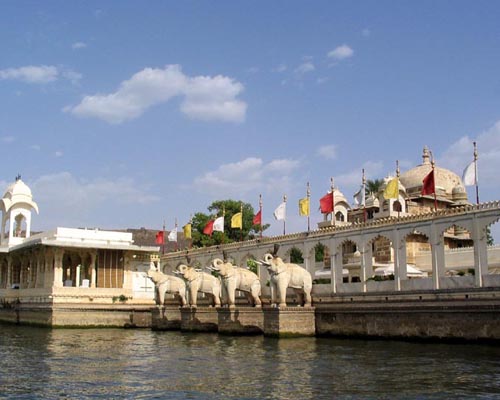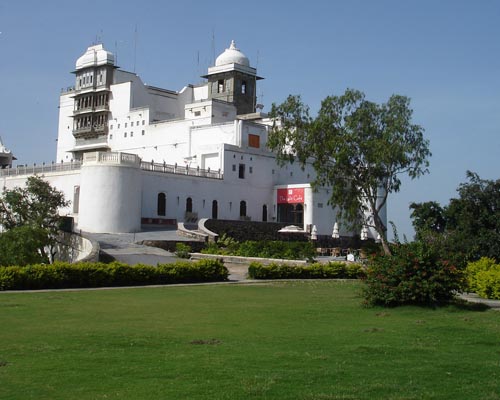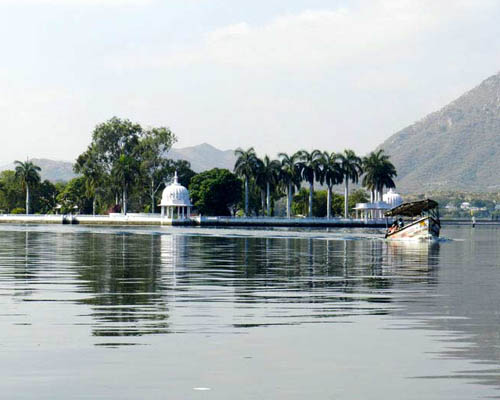City Palace Udaipur
City Palace, Udaipur, is a palace complex in Udaipur, in the Indian state Rajasthan. It is located on the east bank of the Lake Pichola and has several palaces built within its complex. Udaipur was the historic capital of the former kingdom of Mewar in the Rajputana Agency and its last capital. City Palace boasts of the wonderful blend of Medieval, European and Chinese Architecture.
The City Palace built by Rana Udai Singh II has been added to and extended by the successive generations of Maharanas, notably by Rana Karan Singh, and Rana Sangram Singh II. Maharana Sajjan Singh and Maharana Fateh Singh further expanded the palace in the 19th century.
Over the last five centuries, the city palace has been welcoming visitors to its palaces, celebrating ancient indian festivals with pomp and dignity, marking a confluence of the 1500 year-old royal family with the people of mewar and the world.


Lake Pichola
Pichola Lake is one of the most beautiful and picturesque lakes of Rajasthan, India. Located in the heart of the city, Pichola Lake is the oldest and one of the largest lakes of Udaipur. The lake was built by Maharana Udai Singh II. It is one of the several contiguous lakes, and developed over the last few centuries in and around the famous Udaipur city.
Surrounded by the Aravali hills, Pichola lake is nearly 4 km length, 3km width and gets maximum deep at the time of heavy rains, but dry up at the time of severe drought. Rainwater is the main source to fill these lake and when there is more water in the lake, it attracts a lot of Indian and Foreign tourists.
Saheliyon ki Bari
Saheliyon-ki-Bari (Courtyard of the Maidens) is a major garden and a popular tourist space in Udaipur. Saheliyon Ki Bari is one of the most beautiful gardens and a major tourist destination in Udaipur. The garden is famous for its lush green lawns, marble art and fountains. English translation of Saheliyon Ki Bari means "Garden of maids".
This renowned garden is located on the banks of Fateh Sagar Lake, presenting a green retreat in the dry lands of Rajasthan. Garden of maids was built from 1710 to 1734 by Maharana Sangram Singh for the royal ladies.
The main attraction of the garden fountains, which are imported from England. Beak birds get water from the fountains are made. Fountains made of black stone way around. In the garden is a small museum which exhibits a huge collection of goods to the royal family.


Jag Mandir
Jag Mandir is a palace built on an island in the Lake Pichola. The three-storied Palace is a palatial structure made in yellow sandstone and marble. Built in early years of 17th century, Jag Mandir Palace was raised by Maharana Karan Singh to serve as a hiding place for Prince Khurram (popularly known as Shah Jahan).Jag Mandir is situated in one of the two natural islands in the Pichola lake (named after the village Picholi nearby), on its southern end. The lake was initially created in the 15th century by a local banjara tribal chieftain for carrying grain across the streams.
Lake Palace Udaipur
Lake Palace (formerly known as Jag Niwas) is a luxury hotel, which has 83 rooms and suites featuring white marble walls. The Lake Palace is located on the island of Jag Niwas in Lake Pichola, Udaipur, India, and its natural foundation spans 4 acres (16,000 m2).Conceived in romance, the palace was built in 1746 by Maharana Jagat Singh II, 62nd successor to the royal dynasty of Mewar believed to be descendants of the Sun God.


Moti Magri
Atop the Moti Magri or Pearl Hill is the memorial of the Rajput hero Maharana Pratap, which has a bronze statue of the Maharana astride his favourite horse "Chetak". In Hindi, memorial is known as "smarak" and smarak is always made in the memory of loved ones.Maharana Pratap Memorial was constructed with the initiative taken by Maharana Bhagwat Singh Mewar with the help of a public trust. If you are planning a vacation in Udaipur, then you must go visit Moti Magri. It is an intrinsic part of the socio-cultural landscape and hence, offers an insightful peek into life, as it exists in Udaipur .
Gulab Bagh
Gulab Bagh (Sajjan Niwas Garden) is the largest garden in Udaipur. It is spread over 100 acres (40 ha) of land. The garden has innumerable varieties of roses. Gulab Bagh gets its name from the abundance of rose flowers it has. Gulab Bagh was started by Maharana Sajjan Singh in the 1878. It is the fourth oldest zoo in the semi-continent.Apart from the natural beauty, Sajjan Nivas Garden has something more to offer you. Gulab Bagh also encompasses a museum, which was originally known as Victoria Hall Museum. It is famous for its collection of antiques, curios, royal household items and other interesting relics from the past.


Monsoon Palace
The Monsoon Palace, also known as the Sajjan Garh Palace, is a hilltop palatial residence in the city of Udaipur, Rajasthan. It is named as Sajjangarh after Maharana Sajjan Singh (1874–1884) of the Mewar Dynasty, who built Sajjangarh Fort in 1884.It offers a panoramic view of the city's lakes, palaces and surrounding countryside. It was built basically to watch the monsoon clouds; hence, appropriately, it is popularly known as Monsoon Palace.
This Monsoon Palace is situated at such an altitude that it presents magnificent views of Lake Pichola, Aravalli mountains and surrounding countryside. Visitors also love the sunset of Sajjangarh Palace. There is also Sajjangarh Wildlife Sanctuary which encircles the palace. Now it is a forest department property and open for visitors.
Fateh Sagar Lake
Fateh Sagar Lake is situated in the city of Udaipur in the Indian state of Rajasthan. It is an artificial lake named after Maharana Fateh Singh of Udaipur and Mewar ,constructed to the north-west of Udaipur, located to the north of Lake Pichola in the 1680s.Talking about the statistics of Fateh Sagar, the lake extends to the length of 2.4 km, 1.6 km. in width and deep to the extent of 11.5 meter. During the monsoons, the lake covers the total area of around 1 sq km. A beautiful lake, overlooked by a number of hills on the three sides and the Pratap Memorial on the north was built by Maharana Fateh Singh.

